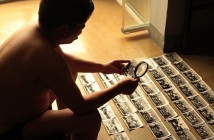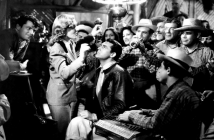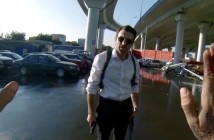
Editor’s Notes: 10 Cloverfield Lane opens in wide theatrical release today, March 11th.
10 Cloverfield Lane may be the most successful audience troll in the modern history of American franchise worship. I mean, for real, did we really need a sequel to Cloverfield, that goofy 2008 wannabe-awesome Gen-Y sci-fi dullard? Did anyone really care? It was a semi-clever high-concept goof with a transparently faux Mini-DV found footage format with characters that weren’t particularly engaging and a monster reveal that was underwhelming at best. The notion that “Cloverfield” is a brand is silly, but the dirty little secret of 10 Cloverfield Lane is that J.J. Abrams and his Bad Robot team are fully aware of that fact. As such, they successfully made this movie in secret, attached the “Cloverfield” name way late in production, and deliver what is essentially a fully original film, connected to the former one in name only, that reaffirms that former film’s relative lameness by being Completely. Freaking. Awesome.
. . . connected to the former one in name only, that reaffirms that former film’s relative lameness by being Completely. Freaking. Awesome.

Yes, 10 Cloverfield Lane is awesome. There may be more eloquent adjectives, but none more appropriate. And when I refer to it as “trolling” the audience, that’s a compliment, for it successfully upends expectations at literally every turn – starting with its surprise announcement, continuing with the co-opting of its title, and proceeding through the film itself, which creates persistent, grating tension for the duration of its running time while keeping a lid on what is actually happening. We think we know what’s going on…and then we think again…and then again…until finally, we’re smacked. It’s a film that is explicitly playing us, but does it so smoothly and efficiently, with such a combination of cinematic intelligence and narrative bombast, that we’re willing and happy to be on the receiving end of its trickery.
I realize I’m being vague. One must be vague in order to sidestep spoilers that, frankly, are essential to a full analysis of this film. And said “spoilers” aren’t necessarily earth-shattering shockers, but merely ingrained within the natural fabric of this screenplay, which functions as a genre-blending Rorschach test that smashes together a handful of completely divergent interpretations. Since we’re familiar with the title and vaguely remember its “predecessor,” there is the threat of sci-fi dangling at all times, but the film proper touches most insistently on coy Hitchcockian bait-and-switch with a thick layer of classic stranded-in-the-middle-of-nowhere pulp, brief jolts of sly Spielbergian serial wonder, and a thread of mild torture-porn satire woven in for shits and giggles. Such a construct might give the impression that the film is a slick copycat, but because it’s so literate in its references and reverence, 10 Cloverfield Lane is able to transcend its inspirations and become something unique unto itself, a trailblazing pop culture punk.
10 Cloverfield Lane is able to transcend its inspirations and become something unique unto itself, a trailblazing pop culture punk.
The confines are tight, with a cast that basically consists of only three people, in one location, over a relatively short period of time. It’s essentially a chamber drama in which Michelle (Mary Elizabeth Winstead) is stranded after a late-night car accident and wakes up in Howard’s (John Goodman) underground bunker. Did he save her or abduct her? The implications swirl but the characters are confined to this space, since apparently there’s been a chemical attack of unknown origin that has left the outer atmosphere unlivable, a convenient layering of conflicts that reflects the film’s self-aware cross-genre proclivities.
Joining Michelle and Howard in hell-once-removed is Emmett (John Gallagher Jr.), an acquaintance of Howard’s who took refuge in the bunker amid the attack, and whose history is something of a mystery. But then, each of these characters is shrouded in some form of mystery – even Michelle, for whom we are only given a hint of a backstory, and who herself isn’t quite sure what happened after her car crash blackout. The strokes of the narrative’s mysteries are fairly broad – one would likely need three hands to count the number of plans that are hatched after discovering a randomly cryptic hint within the bunker – but the character insights are nuanced and ever-fluid, sneaking up on us with surprising resonance. No surprise that this mix of vicious intensity and intimate character detail was co-written by Whiplash’s Damien Chazelle, working from an original screenplay by Josh Campbell and Matthew Stuecken. The result is a delicate balance of emotions, tones, and genre conventions that are both clung to and subverted with varying frequency. First-time feature director Dan Trachtenberg imbues what could be a flatly staged three-person chamber piece with palpable visual energy both showy and subtle, tweaking every sequence with an off-kilter verve.
We’re never quite sure what’s around every corner…or what’s lurking outside…or what the hell is going on in these characters’ minds from one moment to the next. That, in the end, is part of 10 Cloverfield Lane’s grand, pulpy spin – it lures us down the rabbit hole via one genre, navigates us through with another, and lays down yet another joyous gauntlet just when we think we’ve escaped.
And once it’s over, we can’t wait to go back down.
We’re never quite sure what’s around every corner…or what’s lurking outside…or what the hell is going on in these characters’ minds from one moment to the next. That, in the end, is part of 10 Cloverfield Lane’s grand, pulpy spin – it lures us down the rabbit hole via one genre, navigates us through with another, and lays down yet another joyous gauntlet just when we think we’ve escaped. And once it’s over, we can’t wait to go back down.



